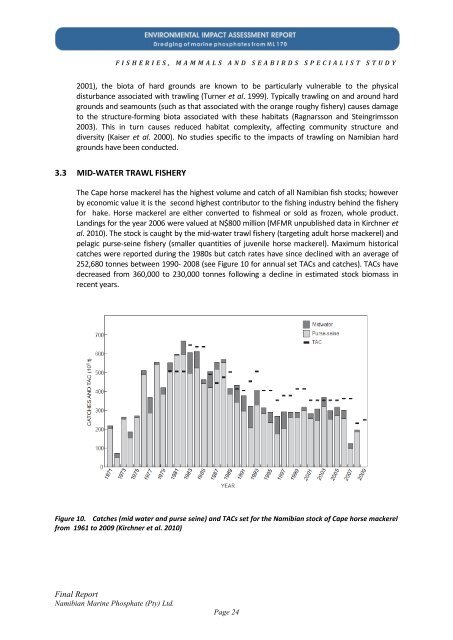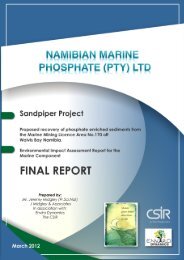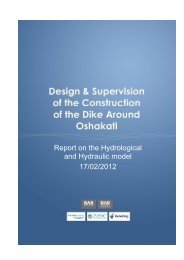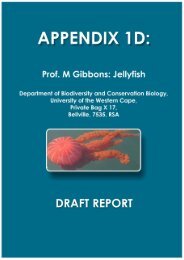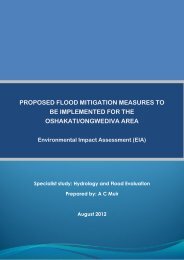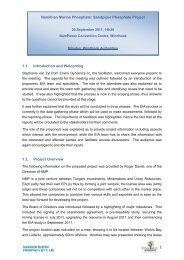Fisheries - Enviro Dynamics Namibia
Fisheries - Enviro Dynamics Namibia
Fisheries - Enviro Dynamics Namibia
Create successful ePaper yourself
Turn your PDF publications into a flip-book with our unique Google optimized e-Paper software.
F I S H E R I E S , M A M M A L S A N D S E A B I R D S S P E C I A L I S T S T U D Y<br />
2001), the biota of hard grounds are known to be particularly vulnerable to the physical<br />
disturbance associated with trawling (Turner et al. 1999). Typically trawling on and around hard<br />
grounds and seamounts (such as that associated with the orange roughy fishery) causes damage<br />
to the structure-forming biota associated with these habitats (Ragnarsson and Steingrimsson<br />
2003). This in turn causes reduced habitat complexity, affecting community structure and<br />
diversity (Kaiser et al. 2000). No studies specific to the impacts of trawling on <strong>Namibia</strong>n hard<br />
grounds have been conducted.<br />
3.3 MID-WATER TRAWL FISHERY<br />
The Cape horse mackerel has the highest volume and catch of all <strong>Namibia</strong>n fish stocks; however<br />
by economic value it is the second highest contributor to the fishing industry behind the fishery<br />
for hake. Horse mackerel are either converted to fishmeal or sold as frozen, whole product.<br />
Landings for the year 2006 were valued at N$800 million (MFMR unpublished data in Kirchner et<br />
al. 2010). The stock is caught by the mid-water trawl fishery (targeting adult horse mackerel) and<br />
pelagic purse-seine fishery (smaller quantities of juvenile horse mackerel). Maximum historical<br />
catches were reported during the 1980s but catch rates have since declined with an average of<br />
252,680 tonnes between 1990- 2008 (see Figure 10 for annual set TACs and catches). TACs have<br />
decreased from 360,000 to 230,000 tonnes following a decline in estimated stock biomass in<br />
recent years.<br />
Figure 10. Catches (mid water and purse seine) and TACs set for the <strong>Namibia</strong>n stock of Cape horse mackerel<br />
from 1961 to 2009 (Kirchner et al. 2010)<br />
Final Report<br />
<strong>Namibia</strong>n Marine Phosphate (Pty) Ltd.<br />
Page 24


